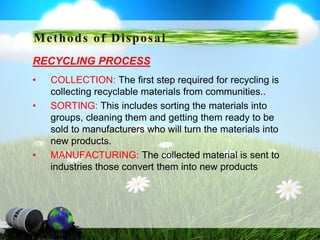Solid waste ppt
- 2. Solid or semi-solid material - which are non soluble in nature. In Simple Words Solid wastes are any discarded (abandoned or considered waste-like) materials. Solid wastes can be solid, liquid, semi-solid or containerized gaseous material. . What is Solid Waste?
- 4. Households or Municipal Waste includes food, paper, cardboard, plastic, textiles, leather, glass, metal, ashes, electronics waste etc. Source of Waste
- 5. Business and Industrial Waste includes toxic chemicals, oil, debris from construction site, packaging waste, ashes etc.
- 6. Agriculture Waste includes pesticides, crops, water coming from the fields also consists of small amount of toxic chemicals.
- 7. Biomedical Waste or Hospital Waste medicine bottles, expired medicines, syringes, medical instruments such as scissors, blades etc.
- 8. Nuclear Waste includes radioactive substances coming from reactors, fuel (uranium, thorium, plutonium etc). Its highly dangerous and requires proper disposal.
- 9. Hazardous Waste includes toxic chemical, acids, corrosive, ignitable and reactive materials, gases etc.
- 10. Hotel Waste includes left over food, empty bottles, and different kinds of trash
- 11. Bio-degradable can be degraded (food, fruits and others) Non-Biodegradable cannot be degraded (plastics, bottles, old machines, cans, containers and others) Classification of Waste According to their Properties
- 14. • Affects our socio-economic conditions • Affects our climate • Affects our coastal and marine environment • Affects our health 14 Impact of Waste to the society If not managed properly
- 15. The 3R’s
- 16. 16
- 19. These are the following methods for disposal of the solid waste. • LAND FILLS • BIOLOGICAL REPROCESSING • RECYCLING • OCEAN DUMPING Methods of Disposal
- 20. LAND FILL It is the most traditional method of waste disposal. Waste is directly dumped into disused quarries, mining voids or borrow pits. Disposed waste is compacted and covered with soil to prevent vermin and wind-blown litter. Methods of Disposal
- 21. OCEAN DUMPING Ocean dumping is the dumping or placing of materials in the ocean, often on the continental shelf. A wide range of materials is involved, including garbage, construction and demolition debris, sewage sludge, dredge material, waste chemicals, and nuclear waste. Sometime hazardous and nuclear waste are also disposed but these are highly dangerous for aquatic life and human life also. Methods of Disposal
- 22. BIOLOGICAL PROCESSING Materials such as plants, food scraps, and paper products can be decomposed into the organic matter. The organic matter that is produced from this type of recycling can then be used for such things as landscaping purpose or agricultural uses. Usually this method of recycling is done by putting the materials in a container and let to stay there until it decomposes. Methods of Disposal
- 23. RECYCLING PROCESS • COLLECTION: The first step required for recycling is collecting recyclable materials from communities.. • SORTING: This includes sorting the materials into groups, cleaning them and getting them ready to be sold to manufacturers who will turn the materials into new products. • MANUFACTURING: The collected material is sent to industries those convert them into new products Methods of Disposal
- 24. RECYCLING PROCESS • PURCHASING: When consumers purchase products that have been made with post consumer material the recycling process has been completed and then can be repeated.
- 26. Operations Information Campaign Increase awareness.. Increase attendance in coastal cleanup activities and street cleaning Support more in tree growing activities. People should learned proper disposal of solid waste and initiated to clean up their surroundings.
- 28. 7.2 million tonnes of hazardous waste One Sq km of additional landfill area every-year Rs 1600 crore for treatment & disposal of these wastes In addition to this industries discharge about 150 million tonnes of high volume low hazard waste every year, which is mostly dumped on open low lying land areas. Solid Waste in India
Editor's Notes
- Kondisyon sa isang pamayanan, malakai ang epektoo nito. Hal. Nakakaka sanhi ito ng baha. Nagkakaroon ng chain reaction .. Tulad ng baha, trapik na nakakaapekto sa pangkabukahayan ng mga tao. Yung mga dpat I deliver hindi agad na dedeliver dahil sa delay. :)





























